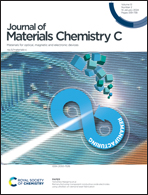Interface passivation with Ti3C2Tx-MXene doped PMMA film for highly efficient and stable inverted perovskite solar cells†
Abstract
Achieving inverted perovskite solar cells (PSCs) that combine high efficiency and long-term stability is still challenging due to intrinsic material issues and low tolerance to environmental factors. The use of an ultra-thin poly(methyl methacrylate) (PMMA) layer to passivate interfacial defects as well as working as a physical barrier to extrinsic factors is promising. However, the low electrical conductivity of PMMA may have deleterious effects on charge extraction. Herein, we explored the use of Ti3C2Tx MXene as a PMMA additive (PMMA:MX) to tune the electrical features of the passivation layers. The optimal concentration of MXenes resulted in improvement of the PSC photovoltaic parameters, boosting their efficiency to 21.30 ± 0.51% (22.1% for the benchmark PSC). Electrical characterizations indicate a reduction of trap state densities accompanied by mitigation of non-radiative recombination. These features contributed to an increase in the extraction of photo-generated carriers and a considerable enhancement of Voc. The improved performance may be attributed to the electrical properties of MXenes and the better wettability of the PMMA:MX interface. Furthermore, the combination of hydrophobic characteristics and passivation features of the PMMA:MX layer resulted in more stable PSCs. The PMMA:MX based devices maintained 95% of their original PCE after 3000 h (ISOS-D-1I) and took 3× longer to reach T80 compared to the control PSC under heat and light soaking (ISOS-L-2).



 Please wait while we load your content...
Please wait while we load your content...